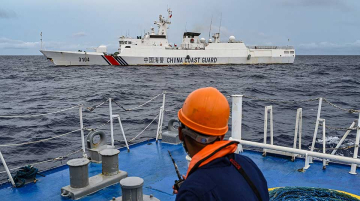
Felix Brender 王哲謙
Last week, tensions in the South China Sea escalated once again, with a collision between Chinese and Filipino vessels, as Manila accused the Chinese coast guard of intentionally ramming the Filipino boat. This incident is, of course, part of a broader pattern of escalating confrontations in the South China Sea over recent months, with video evidence documenting previous skirmishes where Filipino forces have repelled Chinese advances.
These clashes are symptomatic of a larger geopolitical struggle in the Indo-Pacific, where a U.S.-led coalition of democratic nations from Japan to Australia seeks to counterbalance China’s growing influence. Within this context, the Philippines initially attempted to maintain favorable relations with both Beijing and its long-term ally and protective power, Washington, achieving some success before embarking on a dizzying diplomatic zigzag between the two powers.
Initially, Sino-Philippine relations had been constructive, albeit tinged with mutual suspicion. In 2016, President Rodrigo Duterte then dramatically announced it was “time to say goodbye to Washington” and titled the nation closer to Beijing while largely ignoring ongoing territorial disputes with Beijing, in which the Permanent Court of Arbitration in The Hague had already ruled in favor of the Philippines. The honeymoon lasted until promised Chinese development aid, and investment failed to materialize, prompting a more cautious and nuanced approach towards China in Manila.
Now, this reversal has come full circle. In late 2023, the Philippines withdrew from the Belt and Road Initiative—a clear rebuke to Beijing—while granting the U.S. considerably greater access to Filipino military infrastructure. The incumbent President Ferdinand Marcos Jr. has taken a stronger stance on defending Filipino sovereignty, once again aligning the Philippines with Washington.
This shift in Sino-Filipino relations reveals two critical insights about Global China’s ties with its neighbors—and perhaps the Global South more broadly. First, alliances with China are not inexorably moving towards deeper engagement. Commentary often tends to imply that when a former U.S. ally sides with China, it’s a permanent loss for Washington and a perpetual gain for Beijing. This simplistic narrative does not hold true.
Second, this shift illustrates the inherent risks of attempting to “play both sides” in the Indo-Pacific, particularly when one power maintains rigid ideological red lines. Attempting to resolve—or at least shelve—disputes with China by hugging it particularly tight can prove difficult, especially when these disagreements involve issues that Beijing is ideologically unwilling to compromise on. This is true regardless of how accommodating and welcoming the PRC may initially seem.
Putting those allies venturing around at ease, perhaps, Washington appears to be relatively forgiving of allies who stray into Beijing’s orbit—a flexibility that may be a hallmark of a true global superpower.
Felix Brender 王哲謙 is a PhD candidate at the London School of Economics and a Project Associate at LSE IDEAS





